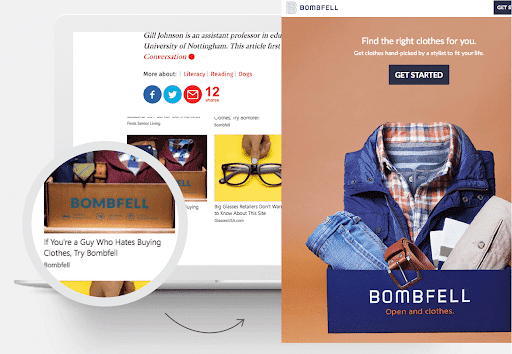There’s no getting around the fact that digital advertising has undergone tremendous change. With rising costs in search and social, shrinking marketing budgets, and changes in how and where people search online, it’s essential to rethink tactics and strategies.
Performance marketers looking for a boost in conversion need to focus on prospective customers in the consideration and action phase of their buyer journey, capturing audiences through high-impact, expertly targeted ads relevant to them.
Two popular ad tactics used to qualify prospects include display ads and native ads. Unsure where to start, or which is right for you? This guide explains the differences between native ads and display ads, in terms of format, performance, revenue, and more.
What Are Display Ads?
Display ads feature an eye-catching look and short copy with a button or call to action, enticing a viewer to click for more information. Often found on web pages, in social feeds, and apps, banner ads are a common example. They vary in shape and size depending where they appear on the screen.

With display ads, it’s clear that they’re promoting something: These ads stand out from the surrounding content, and can be static or include motion (for example, video or microanimations). Success can be tracked in near real-time, making it easy to optimize and adjust ad spend and creative. Ads are served to users based on a mix of demographics, known data, and predicted user intent, ensuring your ads are shown to the people most likely to engage.
What Are Native Ads?
In contrast, native ads blend seamlessly into site content, often looking like and appearing beside articles or longer-form or interactive information. As such, it can be difficult to tell that they are ads at all. Native ads often appear as sponsored, promoted, recommended, or branded content, as in the example below from Avocados from Mexico:

Native ads offer formats that engage audiences, enticing them to stop and interact with the ad. Common native ad formats include in-feed social media posts, games, and maps. Sponsored search results, which blend in with regular results when people are looking for information, are also native ads. See the example below:

Learn more about the pros and cons of native ads.
Key Differences Between Native and Display Ads
There are several key differences between native ads and display ads. With an increased emphasis on ads that stand out and convert, it’s more important than ever to consider what helps with your ad spend and goals.
| Native Ads | Display Ads |
| Match organically with a site’s look and feel. | Stand out as different from the site. |
| More nuanced tactic. | More direct tactic. |
| Consumed as pieces of content. | Consumed as promotional information. |
| Aimed at building brand awareness and consideration. | Aimed at converting prospective customers through action. |
| Suited to drive traffic to site based on placement site’s audience. | Suited for segmented, remarketing, or retargeting campaigns. |
Ads Tailored to Users’ Preferences
Where native ads are static, dynamic ads are, by nature and name, active. You can fight ad blindness and catch a user’s eye with display ads that provide helpful information. Native ads need to be creative and engaging to be effective, but dynamic ads need to be smart: Through high-impact placements on premium sites, dynamic ads can follow a user and serve information they have already searched for with an eye-catching, personalized experience, guiding the user to conversion.
To see an example of this in action, take a look at this case study for Apartments.com. By using a tracking pixel with their website interactions, the brand retargeted visitors who had already viewed rental properties. These ads were dynamically created to display the information they had interacted with, including price and location. Users were motivated to return to their search on Apartments.com and continue their journey, increasing clicks and conversions. By putting this customized ad creative to use and retargeting smartly, the brand generated a cost per lead 54% below its goal.
No matter the format or placement, if an ad provides helpful, relevant information, users are more likely to engage.
Revenue and Traffic
Native ads certainly drive traffic, as they encourage web users to read or watch content related to what they’re already interested in. Bombfell, for example, got a 960% increase in web traffic when running native ad campaigns.

Display ads, on the other hand, do a great job of standing out in a cluttered, disjointed online world where everything is vying for your attention. These high-visibility placements drive audiences to action, with many incorporating AI and predictive analytics to boost results. In an era when audiences are feeling ad fatigue, and marketing teams are pressed for time or resources, utilizing solutions that efficiently repurpose existing assets will save both time and money.
The Bottom Line
Ultimately, both options are worth your while, depending on your goals. While native is great for top-of-funnel, boosting brand awareness early in a user’s buyer journey, display ads are ideal for the performance level of the funnel (consideration and action), creating measurable conversion.
38 Case Studies From Brands That Have Succeeded With Taboola



